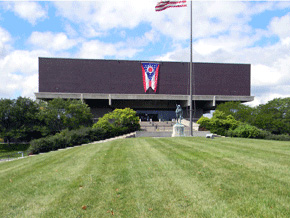GRANVILLE, COLUMBUS
"OHIO HISTORICAL SOCIETY"
The short drive from Granville into the city of Columbus is rewarded with a thriving arts and cultural scene, the Ohio State University, and the Ohio History Center, home of the Ohio Historical Society with its collections, exhibits, shops, and offices. The OHS exhibit is an essential complement to any earthworks tour, as it presents many of the finest artifacts in existence from the earthwork-building cultures, such as the Newark Shaman, the Adena Pipe, the mica hand, many effigy pipes, and huge obsidian ceremonial blades. The center is located just west of the 17th Avenue exit on I 71, north of downtown Columbus.
Exhibits at the Ohio Historical Society’s museum in Columbus include many of the finest objects made and used by the earthwork builders. Startling craftsmanship, wrought upon precious, luminous materials brought to Ohio from all over North America, speak of the genius of these ancient people, and their ways of interpreting the world around them in both ceremonial and functional objects.
Past the museum entrance, and the society’s famous mastodon, the Ohio archaeology exhibit, called “Following in Ancient Footsteps,” presents some of ancient North America’s finest artistry. Curator Brad Lepper explains:
The giant obsidian blades crafted by the Hopewell artisans, the Adena pipe – to see the objects, the artistry, of the people that created these objects, over thousands of years, I think is remarkable. To see the diversity of kinds of things, their beauty, the raw materials that are represented, that’s the most important thing people will see. You go to the sites and you can see the architecture, but you come here to see the things used – both in the daily lives and in the ceremonial lives of the people that built those places.
The story of ancient Ohio is told with these dazzling objects, like “The Shaman of Newark,” and also with earthwork models, both physical and virtual, and a huge 1870s wall-map of the Ohio sites.
Probably the most fascinating of Hopewell era artifacts is the carved stone figure from the Newark ellipse, likely a priest or shaman. He’s holding a human head in his lap, and may be preparing it for burning or burial, or using it for divination. Archaeologist Brad Lepper:
He’s dressed as a bear, a bear’s head on his head, bear claws on his hands, he’s wearing ear spools, and in his lap he’s holding what appears to be a decapitated human head wearing the same style of ear spools. One of the most fascinating things about this is the depiction of a shaman apparently in the very act of transforming into an animal spirit: the hand on the head appears to be either in the act of lowering the mask on his face or perhaps raising it above his face. In fact if you hold it in this manner, and if you’re talking about the shaman’s transformation and simply tilt it, the shaman transforms before your very eyes!
The bear has traditionally meant many things to native people, including awakening after a long hibernation. Sending someone to their burial with such a symbol of rebirth would link them to the renewing circle of life.

The Ohio Historical Society’s exhibits are located in a massive concrete cube from the “brutalist” 1970s, though thanks to a recent renovation it is pleasant inside.


